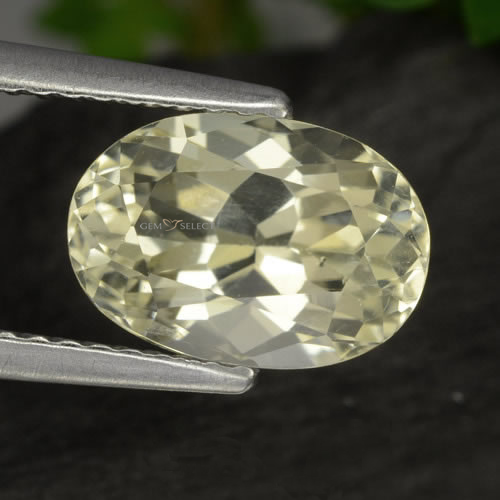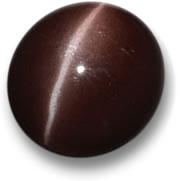Scapolite Gemstone Information

Buy Scapolite Gemstones from GemSelect
About Scapolite - History and Introduction
Scapolite is a fascinating mineral known for its striking colors and unique crystal formation. Often found in shades of yellow, purple, or colorless, it can exhibit beautiful transparency and vitreous luster. Scapolite is primarily composed of aluminum and sodium, and its name is derived from the Greek words "skapos," meaning "shaft," and "lithos," meaning "stone," referring to its elongated crystal structure. Discover our range of scapolite for sale.
Fine gemstone quality scapolite is extremely rare and is sought after by gem and mineral collectors. Due to the rarity of transparent gem quality material, scapolite is considered to be one of the 'lesser-known' gemstones. It also lacks the hardness and durability for most mainstream jewelry use, so it is classified as a collector's stone. On rare occasion, scapolite can exhibit 'cat's eye' or chatoyancy effects. Cat's eye scapolite is exceptionally rare and very valuable. Another rare variety of scapolite is traded as 'rainbow scapolite', and contains iridescent inclusions.
Scapolite was first discovered in Northern Burma (Myanmar) in 1913, in the form of fibrous white, pink and violet crystals. In 1920, yellow scapolite was discovered in Madagascar and ten years later in Brazil. These discoveries were followed by more in Mozambique, Kenya and Tanzania. A purple variety of scapolite from Tanzania, discovered in 1975 is called petschite.
Scapolite gemstone is often confused with golden topaz, golden beryl, chrysoberyl and tourmaline, but these gem types are much harder than scapolite. Scapolite can often be easily identified through simple testing for hardness. Cat's eye scapolite has very distinct and clear 'eyes', which can be helpful when trying to identify it from other chatoyant gemstones. Scapolite is closely related to diopside and chrysolite, also known as olivine or peridot. Distinguishing these materials requires advanced testing methods, such as testing for fluorescence, composition, specific gravity, refractive indices and crystal structure.
Gem quality scapolite is extremely rare, but it can be found in a number of locations around the world. Tanzania is thought to produce the highest quality material. Other notable sources include Brazil, Burma (Myanmar), Canada, Italy, Kenya, Madagascar, Mexico, Namibia, Norway and the USA. Canada is known for a mottled variety of scapolite, closely associated with diopside. Although it is an opaque material, the mottled pattern makes an interesting gemstone when cut en cabochon.
Buying Scapolite and Determining Scapolite Gemstone Value Back to Top
Scapolite Color
The most common color of scapolite is honey yellow, but it is available in other colors such as orange, violet, pink, brown, grey and colorless. Cat's eye scapolite often occurs in greenish, brown and grey. Bright purple scapolite is considered to be the most valuable. Scapolite stones with high color intensity are the most desirable.
Scapolite Clarity and Luster
Scapolite is transparent to translucent and typically occurs with excellent transparency. Inclusions are quite common, especially in larger specimens. All scapolite gemstones exhibit a vitreous luster when cut and polished. Some translucent scapolite gemstones have inclusions that result in chatoyancy (cat's eye effect). These cat's eye scapolite gemstones are rare and extremely desirable because they exhibit a clear and sharp chatoyancy. In gemstones where the chatoyancy is indistinct, they may exhibit adularescence, (a soft white glow). 'Rainbow scapolite' is the trade name given to scapolite that contains iridescent inclusions, which may exhibit spectral colors. Rainbow scapolite may have a colorless, transparent body color, or a darker, translucent greyish body color. Like cat's eye scapolite, the iridescence is best viewed under focused light, such as a penlight.
Scapolite Cut and Shape
Scapolite is typically faceted in a variety of shapes and cut styles, including oval, round, cushion, rectangular, trillion, pear and other fancy shapes. Calibrated sizes can demand high premiums. Scapolite is often found in very large sizes. In fact, most scapolite gemstones are over 6 carats in weight. Translucent materials are typically cut en cabochon to maximize their chatoyancy, as are rainbow scapolite gems.
Scapolite Treatment
Scapolite is not typically treated or enhanced in any way, but some lavender colored stones have been known to be heat treated or irradiated. Irradiated scapolite usually begins as a yellow gemstone and results in a lavender color, though naturally violet scapolite is also available. Treated scapolite stones are known to fade with exposure to heat and light. Natural purple scapolite does not fade in color.
| Chemical Formula: |
Na4Al6Si6O24(CO3SO4) Sodium calcium aluminum silicate |
| Crystal Structure: |
Tetragonal, columnar |
| Color: |
Yellow, orange, pink, violet, brown, grey, colorless |
| Hardness: |
5.5 - 6 on the Mohs scale |
| Refractive Index: |
1.540 - 1.579 |
| Density: |
2.57 - 2.74 |
| Cleavage: |
Good |
| Transparency: |
Transparent, translucent |
| Double Refraction or Birefringence: |
-0.006 to -0.037 |
| Luster: |
Vitreous |
| Fluorescence: |
Pink: orange, pink; Yellow: violet, blue-red |
Please refer to our Gemstone Glossary for details of gemology-related terms.
 |
| Cat's Eye Scapolite |
Scapolite does not have too many closely related gemstones, but it does have close mineral associations with diopside. One of the opaque, yellowish or gray varieties of scapolite from Quebec, Canada is a well-known source, and is often used by local Canadian jewelry designers. The Canadian material occurs opaque with mottled patterns and often multicolored. It has an especially strong level of fluorescence, which makes it quite identifiable. Scapolite is an alteration product of plagioclase feldspar, so scapolite is known to share many similarities with some feldspar gemstones. Since scapolite is an alteration of plagioclase, it shares similar properties with other feldspars.
Golden, yellow and yellow-green varieties of scapolite are actually sometimes considered to be a variety of chrysolite, otherwise known as olivine and peridot. There are also several possibilities for confusion based on appearance alone, such as chrysoberyl, golden beryl (heliodor), sphene, peridot, tourmaline and even rose quartz.
Most Popular Gemstone Trade Names and Mineral Associations:
Diopside, plagioclase feldspar, olivine, peridot, petschite (purple Tanzanian scapolite), cat's eye scapolite, violet scapolite, rainbow scapolite and pink scapolite are the most common trade names and mineral associations.
Lesser-Known Gemstone Trade Names and Mineral Associations:
Wernerite, 'pink moonstone', lavender cat's eye scapolite, violet cat's eye scapolite, pink cat's eye scapolite, mizzonite, dipyre, marialite and meionite are lesser known gemstone trade names and mineral associations.
Scapolite Gemstone Mythology, Metaphysical and Alternative Crystal Healing Powers Back to TopScapolite is not a very well-known gemstone, so it lacks the legend, lore and beliefs that many of the more popular gems have. It is not an officially known birthstone, nor does have any official planetary or zodiac purposes. However, it does still carry a very strong energy, for both mental and physical ailments. This is due to its wide variety of colors. Each color is believed to help with specific areas of life or energy. In general, scapolite can help you find solutions to both past and present problems. This is why scapolite is known as a stone for problem solving. It is also a stone of achievement. It can help bring about change, and provide inspiration and purpose to your life and to those around you. In traditional Hindu belief systems, scapolite is thought to balance the flow of energy in the lower chakras as well as Anahata or the heart chakra, which governs decision making, the emotions and love. Physically, scapolite is thought to help with glaucoma and cataracts. It is also believed to alleviate pain in the shoulders, neck, head and upper chest. Rainbow scapolite with inclusions of magnetite is used in crystal healing jewelry. Magnetite is a magnetic member of the spinel group, and is believed by some to possess beneficial magnetic properties.
| Disclaimer: Metaphysical and Alternative Crystal Healing Powers and Properties are not to be taken as confirmed advice. Traditional, Ceremonial and Mythological Gemstone Lore is collected from various resources and does not represent the sole opinion of SETT Co., Ltd. This information is not to replace the advice of your doctor. Should you have any medical conditions, please see a licensed medical practitioner. GemSelect does not guarantee any claims or statements of healing or astrological birthstone powers and cannot be held liable under any circumstances. |
Scapolite Gemstone and Jewelry Design Ideas Back to TopScapolite is extremely rare and virtually unheard of by most. It is not a type of gemstone you'll find in local jewelry stores, so there is little to no demand for scapolite jewelry. However, due to the attractive colors of scapolite, especially honey-yellow, you may find some rare jewelry designs that incorporate scapolite gemstones. These jewelry designs will be made usually by those who are true gem connoisseurs. If using any type of scapolite in jewelry, it is best to limit its use to earrings, pins, pendants or brooches, because of its lack of durability. Scapolite does have a good level of brilliance and an attractive vitreous luster, so when set with white or yellow precious metals, the results can be fantastic. Cat's eye scapolite is ideal for cabochon earrings, but not really suitable as a gemstone cabochon ring as it is rather soft. The chatoyancy is especially sharp with scapolite, and the cat's eye effect can often be very striking.
Note: Buy colored gemstones by size and not by carat weight. Colored stones vary in size-to-weight ratio. Some stones are larger and others are smaller than diamonds by weight in comparison.
Master lapidarist, Buzz Gray and jewelry designer, Bernadine Johnston have created a series of gemstone butterfly brooches that are exhibited in LA's Natural History Museum. One butterfly, called the "Ninja" features purple Tanzanian scapolite gemstones.
Scapolite Gemstone Jewelry Care and Cleaning Back to Top Scapolite's Mohs scale hardness of 5.5 - 6 means that it should be properly cared for in order to maintain its beauty. Since household dust contains quartz, which has a Mohs scale hardness of 7, simply wiping dust from a scapolite gemstone could cause scratches. The best way to clean scapolite gemstones is by using soapy water and a soft cloth. Be sure to rinse well to remove soapy residue. Do not expose scapolite to sudden changes in temperature. As with most gemstones, ultrasonic cleaners and steamers are not recommended. Always remove any jewelry or gemstones before exercising, cleaning or engaging in harsh physical activities such as sports. Scapolite can be easily scratched by harder substances, so it should be stored away from other gemstones. It is best to wrap gemstones in soft cloth or place them inside a fabric-lined jewelry box. Scapolite's Mohs scale hardness of 5.5 - 6 means that it should be properly cared for in order to maintain its beauty. Since household dust contains quartz, which has a Mohs scale hardness of 7, simply wiping dust from a scapolite gemstone could cause scratches. The best way to clean scapolite gemstones is by using soapy water and a soft cloth. Be sure to rinse well to remove soapy residue. Do not expose scapolite to sudden changes in temperature. As with most gemstones, ultrasonic cleaners and steamers are not recommended. Always remove any jewelry or gemstones before exercising, cleaning or engaging in harsh physical activities such as sports. Scapolite can be easily scratched by harder substances, so it should be stored away from other gemstones. It is best to wrap gemstones in soft cloth or place them inside a fabric-lined jewelry box.
|
